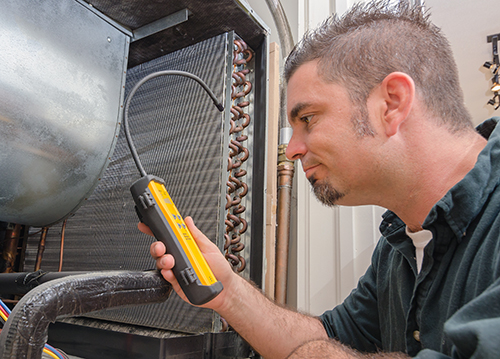The connections between a furnace and duct system are rarely considered as a cause of cracked heat exchangers. Commonly repeated mistakes with return and supply duct connections significantly impact airflow and the length of time before you’re back for repairs. Let’s look at some these issues that may be killing airflow and the heat exchangers in your systems.
Restrictive Return Fittings Impact on Heat Exchangers
Undersized return drops and sharp transitions restrict airflow before it can circulate through the furnace. One of the best examples of this is a 100,000 – 120,000 Btu input furnace that requires return air to be brought in from both sides of the furnace or from the bottom.
In many installations this necessity is ignored and a single-return drop with a 16 x 25 x 1-in. filter is installed regardless of furnace size. Heat exchangers suffer drastically reduced lives, as proper airflow is unable to move across that filter.
Contractors often assume a blower will pull airflow regardless how return fittings are installed. If the duct is large enough to move the proper amount of air, it should work as intended. This is a dangerous assumption to make. Depending on the number of turns built into fittings, serious airflow reduction can occur.
Sharp turns in a duct system can effectively reduce the size of an opening when air makes a 90-degree turn. When air goes around a sharp turn, it creates a tremendous amount of turbulence and air speed decreases.
Make sure your return fittings are sized correctly and installed properly for the application. They work best when you use long sweeping bends that allow airflow an easy path to travel back to the furnace.
Heat Exchangers and Poor Filter Installation
Installing the filter at the inlet of a furnace is another issue to consider. A filter installed in a location that isn’t best for airflow reduces its effectiveness because the full area of the filter isn’t used. Factory filter racks are often improperly sized and allow a tremendous amount of unfiltered air to bypass the filter due to their design.
Incorrectly sized and restrictive filters also greatly reduce airflow across heat exchangers and lead to unnecessary overheating. This condition occurs even when the filter is clean. They are too restrictive for the right amount of airflow that must move through them.
Consider increasing your filter sizes or add an extra filter when this is a concern. Using filter grilles is an easy way to increase filter surface area where conditions permit. Think twice about installing 100,000 Btu input furnaces with a single 16 x 25 x 1 filter.
Undersized Coil Opening
This is common in the north where cooling loads are low and heating loads are high. Typically contractors place an extremely small evaporator coil, matching the cooling load, on top of a larger furnace.
The smaller evaporator coil restricts airflow due to its high pressure drop and creates excessive supply-side static pressure. This installation kills heat exchangers, as the furnace can’t move proper airflow through the coil. The furnace continually cycles on high limit causing undue stress on heat exchangers and eventual failure.
Correct this condition by using a larger evaporator coil closer to the size of the furnace.
Deadhead Plenums
Deadhead plenums leave air with no direction as it exits a furnace. Air ends up “splatting” into the end of the duct creating a tremendous amount of turbulent airflow.
Air coming out of the furnace has a continual pileup with a few lucky cfm able to escape the duct. If you ever experienced temperatures much warmer on one side of the duct system than the other, you’re seeing the results of this installation technique.
A better option is to use a properly sized plenum with take offs that have an opening sized approximately 50 percent larger than the duct. This gives air coming out of the furnace a low-pressure path to smoothly merge into the duct system.
Pan and Duct Discharge
The practice of panning off the top of an evaporator coil and tapping a round duct directly into it has never made sense. This chokes off the coil opening and creates an extreme amount of turbulence. The result is that air often recirculates in the coil box.
Correct this issue by installing a long centerline square-to-round transition coming off the coil to the round duct size. Air will flow much smoother out of the furnace with this style duct fitting.
You really increase the chances of premature heat exchanger failure and poor performance when you make any of these common installation mistakes. Who is to blame when heat exchangers fail under conditions like this? It probably isn’t the equipment’s fault.
The answers are out there and together we will find them. If you need any additional information on this material or have any questions feel free to e-mail me at doccombustion@gmail.com.

